Highlights
- The cross-country relationship between female labor force participation and fertility has not changed nearly as much as researchers suggest. Post This
- In recent decades, where female labor force participation has risen, fertility has fallen. Post This
- While this “new era” in the economics of fertility has been announced with great fanfare, there are strong reasons to be skeptical. Post This
In the early 2000s, a number of sociologists noticed an interesting fact: while for many years there had been a negative correlation between a country’s female labor force participation rate and fertility, by the late 1990s, the relationship had flipped, and countries where women worked more seemed to have higher fertility than others. This initiated a major reconsideration of fertility, which in recent months has led a team of economists at the National Bureau of Economic Research (NBER) to proclaim a “new era” in the economics of fertility. Today, they suggest, fertility is mostly governed by the extent to which women can accommodate the competing demands of careers and childbearing: where social, economic, and political structures provide women more support, fertility is higher. The upshot of this view is that if countries want to increase their fertility rates, they should consider policies aimed at boosting women’s career success, getting men to help more with chores at home, and heavily subsidizing child care services.
However, while this “new era” has been announced with great fanfare (and covered in many news outlets), there are strong reasons to be skeptical. Not every analysis presented in the recent review of these theories can be addressed here, but a few of the most prominent and widely distributed claims can. In particular, a careful review of the data suggests that 1) the cross-country relationship between female labor force participation and fertility has not changed nearly as much as researchers suggest; 2) at the individual level, it has not changed at all: women and men who value work more have fewer children; 3) in longitudinal analysis of countries, it has not changed at all: when female labor force participation rises in a country, fertility falls; 4) and men’s share of housework has little predictive value for fertility outside of a highly selective sample.
Cross-Country Correlations Between Women’s Work and Fertility
Many researchers have observed that whereas in the past fertility and work seemed to compete for women’s time, in more recent years, countries where women work more also have higher fertility. In Figure 1 below, the dark blue line is produced replicating a key chart from the recent NBER study: within OECD countries, women working more predicted lower fertility in the 1970s, higher fertility in the 1990s, and over time has drifted back towards zero. Already, the “new economics of fertility” face a problem: maybe in the 1990s women working more led to higher fertility, but we are already seeing a shift away from that dynamic.
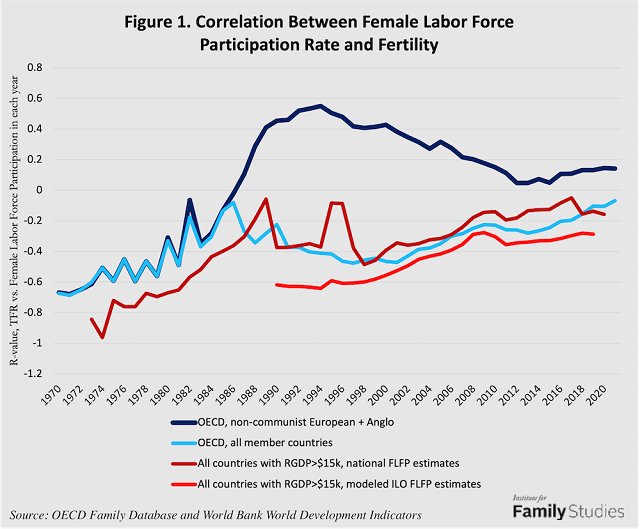
But of course, what’s presented in the blue line is a peculiar slice of the data: it includes only OECD member countries in Europe or outside of Europe who speak English (including Australia but not Japan, for example), and excludes current European OECD member countries who were formerly communist. That yields 22 countries out of 38 total OECD members. Expanding the pool of data to all OECD members yields the lighter blue line: the correlation between fertility and female labor force participation never turned positive.
But there’s no reason to limit ourselves to the OECD. I use data from the World Bank to look at all countries with inflation-adjusted GDP per capita in a given year of $15,000 or more to see how their female labor force participation rates compare to fertility. In such a large global panel, data quality can be an issue, so I show results using both sometimes-idiosyncratic, nationally-provided estimates (dark red), and model-based estimates of female labor force participation from the International Labor Organization (light red). These latter estimates are only available since 1990 across the widest range of countries.
The more countries I include, the more negative the correlation between fertility and female labor force participation becomes. Indeed, it is only in the narrow subset of western European countries where the positive correlation emerges, and there the correlation is driven almost exclusively by the Scandinavian countries, whose situation may be unique and irreplicable.
Men and Women Who Put More Value on Work Have Fewer Children
In a recent global report for IFS, Laurie DeRose and I reviewed the evidence on the connection between work attitudes and fertility around the world. We found that regardless of country-level correlations, at the individual level, men and women who placed a higher priority on work had fewer children. This relationship persisted across multiple different survey programs and indicators and was robust to many different model specifications. The more people derive a sense of meaning, value, and worth from their jobs, the fewer children they tend to have. This applies to men as much as to women: men who see their career as the main source of meaning are less interested in fatherhood. This raises serious questions about the extent to which policies aimed at work-family balance can boost fertility. Such policies might create more family-friendly workplaces, or they might simply create more work-friendly families, leading to more work rather than more babies.
Over Time, Rising Female Labor Force Participation Associated with Lower Fertility
Neither cross-country correlations in a given year, nor individual-level associations with attitudes, are good representations of how policymakers can influence fertility. Rather, policymakers should be interested in how a given country’s fertility changes in response to changes in some other variable, in this case, the female labor force participation rate. That requires the use of longitudinal models, and in particular, panel models with fixed effects.1 Appropriate data for estimating this kind of model exists for many countries from 1990 to 2020. Figure 2 below shows model estimates of fertility changes in response to changes in the female labor force participation rate in the period 1990-2020, broken out by countries’ income levels in 1990.
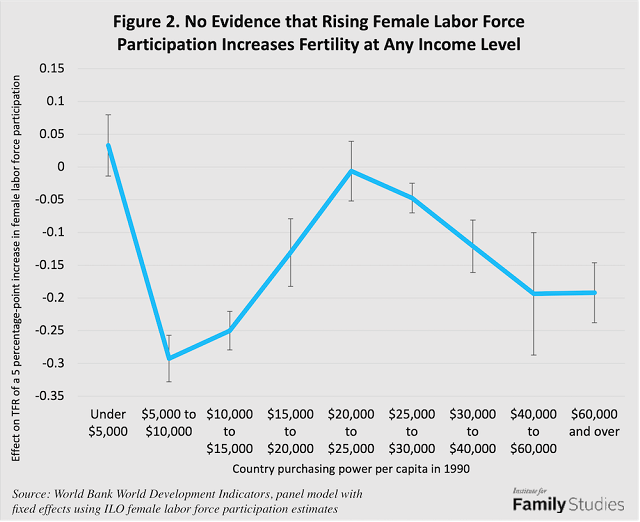
As can be seen, richer and poorer countries both see their fertility rates fall when female labor force participation rises. There is some noise and volatility within various income ranges, but overall, there’s no evidence that in recent decades the historic negative link between work and fertility has changed. In an additional analysis, I found that there was no significant difference between the work-fertility relationships in high income countries between 1990-2000 and 2010-2020. Put simply, in recent decades, where female labor force participation has risen, fertility has fallen.
Perhaps the most striking recent example of a failed policy in this area is Japan. Under Japan’s “Abenomics,” the country hoped to increase fertility rates by easing women’s work-life balance. The Japanese government pushed companies to hire more women and greatly increased funding for child care, with the result that Japanese women’s labor force participation rates skyrocketed. And yet, from 2013 to 2019, when “Abenomics” was in full swing, Japan’s fertility rate fell from 1.43 to 1.36. Easing work-life balance and helping women advance their careers will not necessarily have a positive effect on fertility.
Men Doing More Chores Won’t Boost Fertility
A core part of the NBER study uses a range of data on men’s contributions to housework to argue that when men help more at home, fertility rises. Figure 3 below is duplicated from the NBER study and shows their findings.
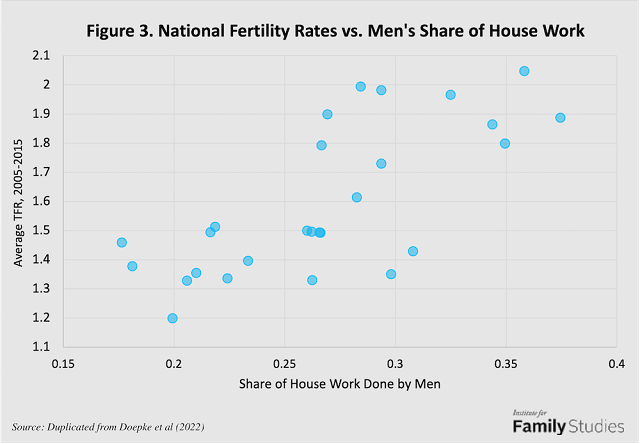
This is a longstanding argument in sociology of the family, fleshed out here in greater length. However, there are real problems with this approach, largely related to major ambiguities in the extant data about housework and childcare. The study authors use data from the 2012 International Social Survey Program (ISSP) to make their case, a dataset that has many different ways to measure housework. Broadly, the ISSP measures housework contributions by asking: 1) about weekly hours spent on housework by the respondent and the respondent’s partner (4 questions); 2) who usually does each of a set of common household chores (respondent or partner) (6 questions); 3) how fairly respondents feel their housework is divided with their partner (1 question); 4) who chooses weekend activities (1 question); 5) and whether respondents are too tired from a job (or housework) to contribute at home (or to have a job) (4 questions). Which of these measures is the best way to measure housework?
The NBER study authors compare only the housework contributions of men and women who specifically reported living together (whether married or not) and who have young children at home and who lived in a subset of high-income ISSP countries. In that group, they aggregate the reports of who does common household chores, so if men report doing more cleaning than women, that’s in their favor, while if women report doing more grocery shopping than men, that’s in their favor. The authors treat all 6 chores equally, even though obviously chores like “small repairs around the house,” “preparing meals,” “care of sick family members,” and “cleaning” may not actually take similar amounts of time, effort, or attention.
But what happens if we include just a bit more or different data than the NBER authors included, as I did for the cross-country correlations? To begin with, I attempt to replicate the results published by the NBER team in Figure 3. Rather than show numerous graphs, Figure 4 reports just the correlation coefficient resulting from each adjustment to the NBER model. Even after correspondence with the authors, I have been unable to exactly replicate their results, and they have not yet posted replication data files (though they intend to do so eventually). Nonetheless, I am able to produce very similar figures: whereas the NBER study reports a 0.72 correlation between men’s housework and fertility, I am able to arrive at a 0.67 correlation.
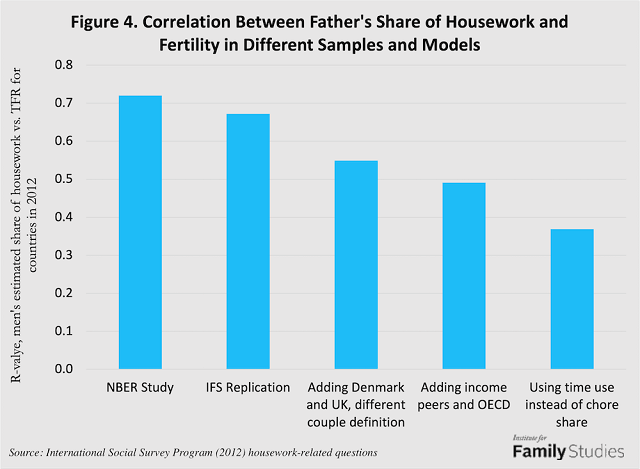
In correspondence with the study authors, they noted that they dropped two countries (Denmark and Great Britain) because those countries did not have data on cohabiting partners. This is true; those countries didn’t ask a specific cohabitation question. However, in every country which asked about division of labor, unmarried people were asked the question as well, and could report the presence of unmarried partners. As such, it is straightforward to correct this erroneous omission. When Denmark and Great Britain are added back in and couples are defined by reported presence of a partner in the housework questions, the correlation drops to 0.54.
But what about other countries? The NBER study authors used data from 28 countries, despite 40 countries with data available. Their selection criteria was idiosyncratic: relatively high-income countries like Taiwan, Russia, Chile, and Israel were excluded, as were industrialized OECD countries like Mexico. Adding in these five countries (but still excluding low-income, non-OECD countries) reduces the correlation to about 0.49: still fairly high, but suggesting once again that as the sample is expanded to a more representative set of countries and indicators, the observed relationship weakens.
Expanding the countries included isn’t the only important analytical check on the claim that men doing more chores leads to higher fertility. None of the chores listed refer to child care and the time spent on each chore is unclear. Reported time use on housework may be a more valid indicator. The correlation between “share of chores” and share of reported hours of housework is surprisingly low: just 0.47, suggesting that time spent on housework is measuring something different than the “share of chores” indicator. Using this alternative, more expansive measure which does include child care, the correlation drops again to 0.37. This is still a reasonably meaningful and positive correlation. But it’s far weaker than the initial relationship shown in the NBER study, with much of the weakening relationship caused by simply correcting unexplained omissions in the data the authors chose to include.
It’s possible that other measures of housework would yield stronger or weaker correlations. But there is also good reason to be skeptical that men’s housework will boost fertility. First, academic research has shown that when men do more housework, they start to experience the same work-family balance challenges as women, and their fertility desires may decline, so that overall fertility is unchanged. Second, although extensive academic research has shown that getting child care help from outside the couple does boost fertility, it is peculiar to suggest that couples can boost their fertility just by reshuffling who does what task. Most couples manage their paid and unpaid workloads with some degree of joint consideration, and so it’s not clear why, if one partner is overworked, shifting their workload to the other would cause the couple to jointly adopt higher fertility intentions: a husband now doing more work at home likely compensates by spending less time working, plausibly reducing the couple’s income, creating new hardships. It’s important understand here is that in detailed time use surveys, mothers and fathers report very similar overall amounts of time spent on sleep, personal care, and recreation; there just are not big gender differences in available “free time,” so there isn’t a lot of “low hanging fruit” where dads can help out more at home without sacrificing something else of value to their family. If a couple is overworked, then they are overworked, regardless of how they divide the labor.
The ISSP also includes questions about fertility ideals. Figure 5 shows that fertility ideals are barely changed by large differences in their partner’s housework hours. Although effects are statistically significant, note that even a 15-hour change in a wife’s housework only raises a husband’s fertility ideals by 0.06 children. This is a small effect.
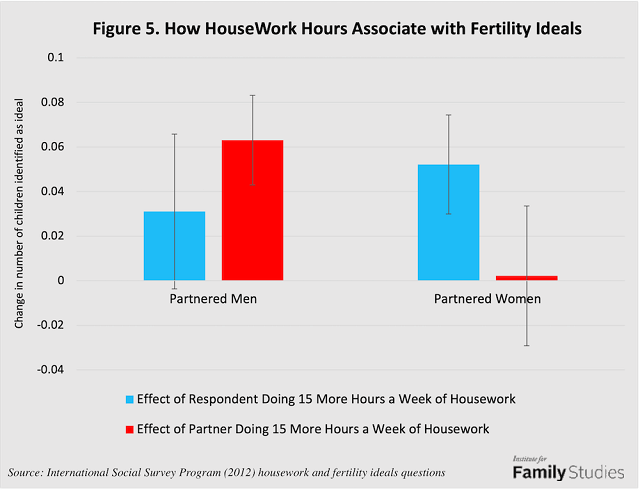
It’s worth noting as well that for both male and female ISSP respondents who worked and had families, the more they reported that they were too tired from doing paid work outside the home, the fewer children they reported desiring. On the other hand, the more tired both men and women reported being from housework, the more they reported wanting more children. Stressful jobs make people not want kids; exhausting work at home, however, doesn’t have as negative an association. People who are exhausted at home are not reporting regrets about their kids or a desire to have fewer. Since there is not a strong association between measures of housework and fertility ideals in the ISSP, and since the correlation between husbands’ housework and national fertility rates is highly sensitive to exact model specifications, the evidence for the supposed link between men doing more chores and higher fertility rates seems relatively weak.
Conclusion
For several decades, sociologists have explored “feminism as the new natalism,” or whether fertility can be increased by helping women achieve greater work-life balance. The evidence for this view remains mixed. This recent study describing a “new era” in the economics of fertility goes to great lengths to point out how fertility is changing, and especially how economists’ understanding of fertility has changed. In particular, economic research on fertility is making a fuller consideration of attitudes, ideals, and values apart from just childrearing costs.
However, there are good reasons to be skeptical of the core claims of this new study with regards to work-family balance and fertility. Certainly, providing families more support can induce higher fertility. But aid focused on helping women (or men) fit family into their career is putting the cart before the horse; it neglects to recognize that this career prioritization is a core driver of low fertility, and that policies aimed at harmonizing families with the demands of careers may simply lead to even more prioritization of work and even lower fertility. If policymakers really want to help families achieve their goals, they must help families reduce their total work burdens, not simply swap paid work for housework. Policymakers should focus on reducing the costs of child care, reducing barriers to marriage and homeownership (precursors to fertility in many cases), and helping young families make ends meet without working long and irregular hours.
Lyman Stone is a Research Fellow at the Institute for Family Studies, Chief Information Officer of the population research firm Demographic Intelligence, and an Adjunct Fellow at the American Enterprise Institute.
1. These models assess how an outcome variable (fertility) usually changes when an input variable (female labor force participation) changes, within countries, ignoring fixed differences across countries within a given time period.











